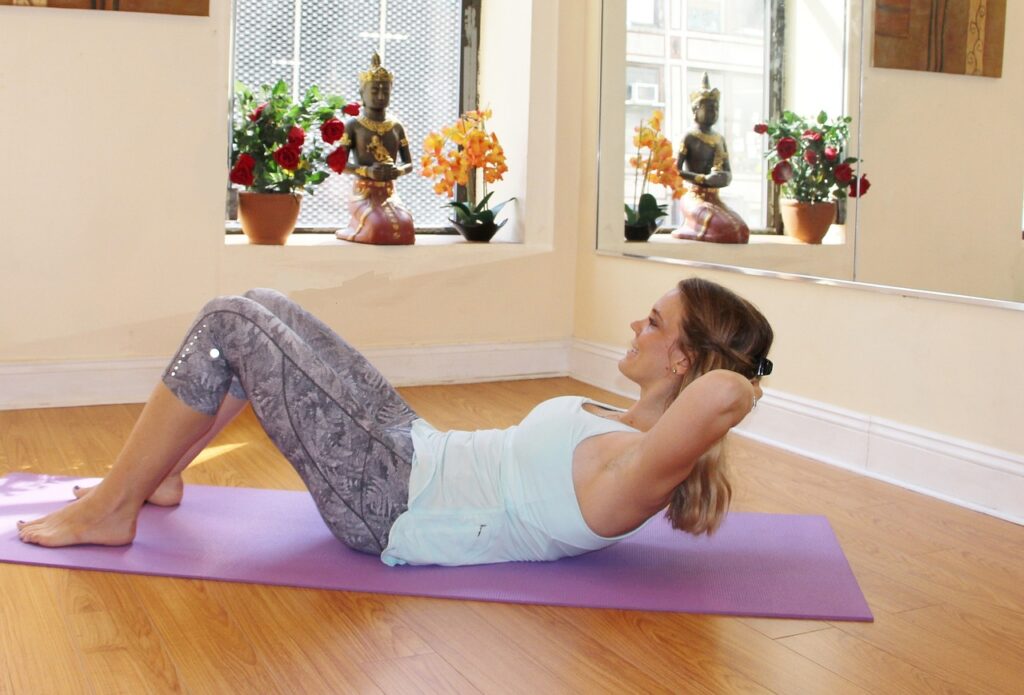
Introduction
Are you torn between embracing the power of Pilates or diving into the world of yoga? Let’s compare Pilates and yoga to find which exercise is right for you. It’s challenging to determine which practice best fits your needs.
Because Pilates and yoga offer so many physical and mental benefits. They promote strength, flexibility, and mental well-being. However, while Pilates and yoga share some common ground, they also have distinct features that set them apart.
This article will explore Pilates and yoga, examining their similarities and differences to help you find the perfect fit. Discover what sets each practice apart and understand the unique features that make Pilates and yoga special.
Pilates and Yoga: Key Similarities
Although Pilates and yoga have many similarities, Pilates has its own distinct features.
There are also many differences between Pilates and yoga. Pilates and yoga are exercises that focus on controlled movements and breathwork.
Here are some key similarities between Pilates and yoga:
1. Mind-body connection: In both Pilates and yoga, there is an emphasis on connecting the mind and body. They both encourage you to be present in the moment and pay attention to your movements and breathing.
2. Core strength: Both Pilates and yoga work to strengthen your core muscles, which include the muscles in your abdomen, back, and hips. Having a strong core helps with overall body stability, balance, and posture.
3. Flexibility: Both practices help improve flexibility. They involve various stretching movements and postures that target different areas of the body, such as the legs, arms, and spine. Regular practice can help improve your flexibility over time.
4. Breathing techniques: Both Pilates and yoga emphasize the importance of proper breathing. They teach you to breathe deeply and fully, which can help reduce stress, increase relaxation, and enhance your overall well-being.
5. Full-body workout: While they have different focuses, both Pilates and yoga provide a full-body workout. They involve different exercises and poses that target various muscle groups, helping to strengthen and tone your body. Regular practice can improve your overall fitness, endurance, and muscular strength.
6. Low impact: Both Pilates and yoga are low-impact forms of exercise. This means the exercise is gentle on your joints and can be practiced at a slower pace for all fitness levels. This will help improve your fitness without putting too much stress on your body.
7. Stress relief: Both practices can help reduce stress and promote relaxation. They often incorporate mindfulness and meditation techniques to help calm the mind and improve your mental well-being.
Remember, it’s always a good idea to consult a fitness professional or a doctor before starting any new exercise program, especially if you have specific health concerns or conditions. They can provide personalized guidance and ensure you engage in safe and effective workouts.
Pilates and Yoga: Key Differences
One of the main differences between Pilates and yoga is the use of equipment.
While yoga is typically done on a mat, Pilates incorporates equipment such as spring tension to provide resistance and assist movement. Before moving on to the mat, this can make learning the basic activities easier.
Another key difference is the emphasis on control and coordination in Pilates. While yoga also focuses on these aspects, Pilates emphasizes centering the body and the breath.
Pilates and yoga share many principles, so it’s not surprising that overlap exists. However, there are some critical differences between the two practices.
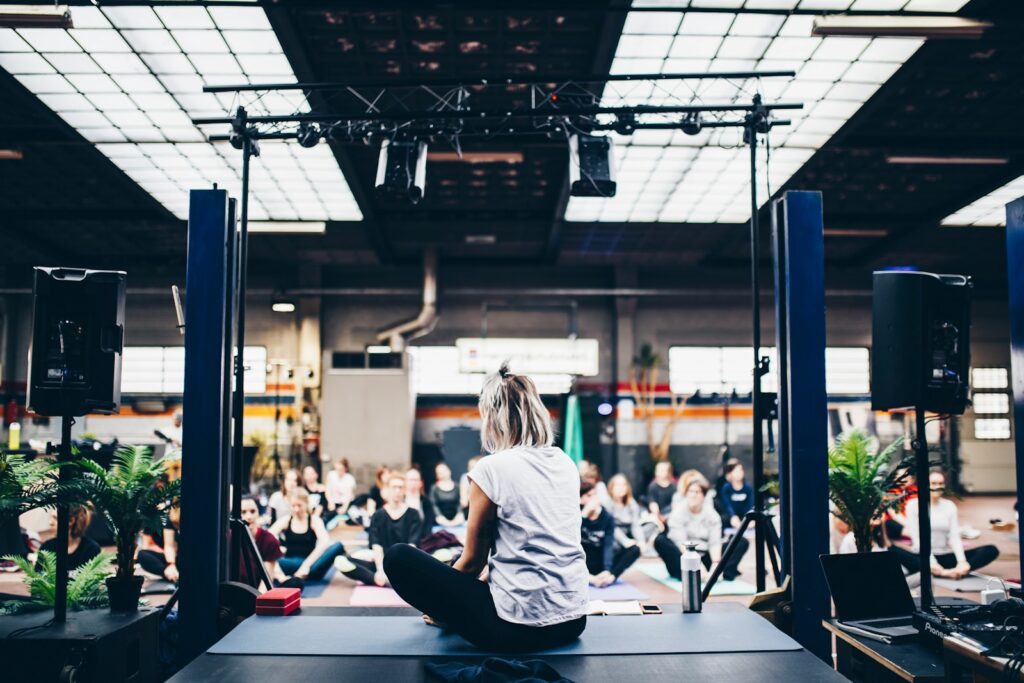
The Differences Between Pilates And Yoga
1. Origins: Yoga is an ancient practice that originated in India thousands of years ago, whereas Pilates was developed in the early 20th century by Joseph Pilates.
2. Focus: While both practices emphasize mind-body connection, yoga primarily focuses on flexibility, strength, and balance, while Pilates places more emphasis on core strength, stability, and alignment.
3. Breathwork: Pilates and yoga incorporate breath awareness, but the techniques and emphasis differ. In yoga, specific breathing techniques (pranayama) are commonly used to activate energy and induce relaxation. In Pilates, breath control aids in stabilizing the core and enhancing your movement.
4. Spiritual Aspect: Yoga often incorporates spiritual and philosophical elements, such as meditation, chanting, and uniting mind, body, and spirit. Pilates, on the other hand, is more exercise-oriented and does not have the same spiritual aspect.
5. Movements: Pilates exercises are more structured, repetitive, and focused on specific muscle groups, while yoga has a broader range of movements and poses that flow together in sequences.
6. Equipment: Pilates can be done on a mat, but it also utilizes specialized equipment such as reformer machines, Cadillac, and chairs. This equipment provides resistance and assistance, allowing for various exercises and modifications. Yoga, on the other hand, traditionally uses minimal equipment and is primarily practiced on a mat.
7. Intensity: Pilates exercises can be challenging and intense, focusing on building strength, flexibility, and endurance. While still complex, yoga often emphasizes relaxation, mindfulness, and finding balance.
8. Focus On The Core: Pilates places a heavy emphasis on developing a strong core, including the abdominal, back, and pelvic muscles. Yoga also engages the core but explores a broader range of movements and does not solely focus on core strength.
9. Mental Focus: Both practices promote mental focus, but yoga often incorporates meditation, visualization, and mindfulness exercises more extensively than Pilates.
10. Variety and Progression: Yoga offers a wide variety of styles and practices, ranging from gentle and restorative to vigorous and challenging. Pilates has a more standardized approach and is often taught progressively, building upon foundational exercises before moving to more advanced movements.
Choosing Pilates or yoga depends on your preferences, goals, and fitness level. Some people may enjoy and benefit from both practices, as they can complement each other and provide a well-rounded approach to physical fitness and overall well-being.
Key Takeaways:
- Origins: Pilates was developed by Joseph Pilates in the early 20th century, while yoga has ancient roots in India.
- Focus: Pilates emphasizes core strength, stability, and alignment, while yoga focuses on flexibility, strength, balance, and spiritual aspects.
- Equipment: Pilates utilizes specialized equipment like reformer machines, whereas yoga traditionally requires minimal equipment.
- Movements: Pilates exercises are structured and repetitive, while yoga incorporates a broader range of movements and poses.
- Spiritual aspect: Yoga often incorporates meditation, chanting, and spiritual elements, while Pilates is more exercise-oriented.
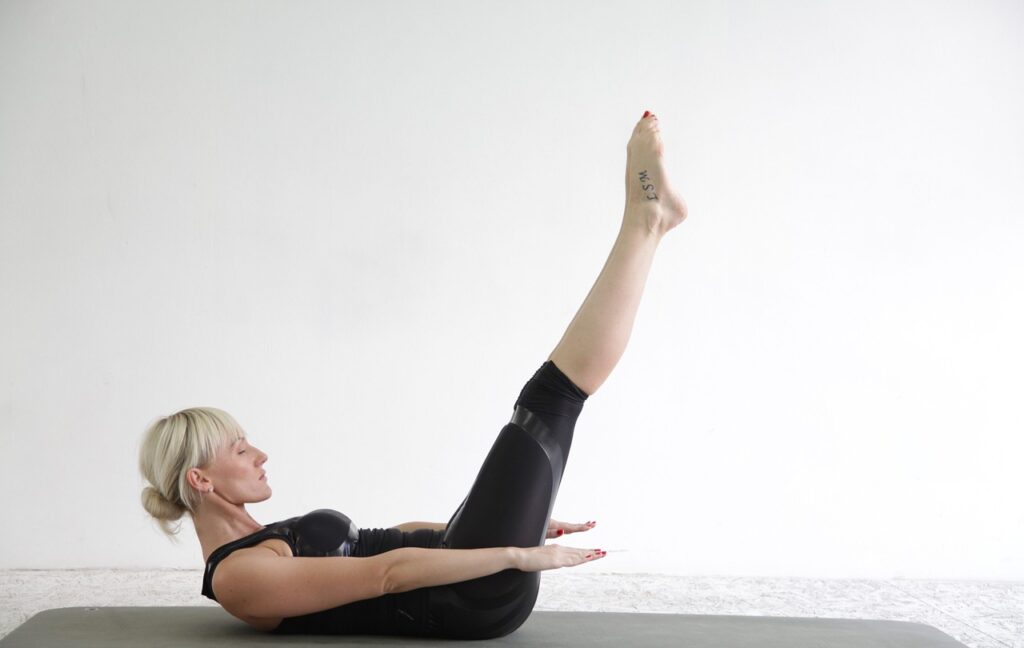
Similarities and Contrasts: Pilates vs. Yoga
Pilates and yoga share many similarities, with Pilates being partly based on yoga. Both practices emphasize control, centering, coordinated movement, and breath. The principles of both approaches overlap, making them complementary to each other.
However, there are also some differences between the two practices. In yoga, practitioners usually work with their bodies on a mat without help. This can be challenging but allows for a deeper connection with the body.
Pilates also involves working on a mat, but it also incorporates the use of different pieces of equipment. Some of this equipment includes spring tension, which can be both resistive and assistive. This can help beginners learn the basic movements of the exercises and accomplish them more easily.
Similarities:
- Mind-body connection: Pilates and yoga emphasize the relationship between the mind and body.
- Core strength and stability: Both practices prioritize the development of core strength and stability.
- Control and precision: Pilates and yoga emphasize controlled movements and precise execution.
- Coordinated movement: Pilates and yoga involve coordinated movement patterns and transitions.
- Breathwork: Both practices incorporate breath control to enhance focus and engage the core.
Use of Equipment in Pilates
While Pilates and yoga share many similarities, one key difference is the use of equipment in Pilates. While yoga is typically practiced unassisted on a mat, Pilates incorporates various equipment to aid the exercises.
This equipment can include spring tension, which can be both resistive and assistive. Spring tension can help beginners learn the basic movements of the activities and make them easier to accomplish.
Role of Spring Tension in Pilates
Spring tension is a unique aspect of Pilates that sets it apart from yoga. Using spring tension in Pilates equipment can provide resistance and assistance to the practitioner. This can help individuals learn the basic movements of the exercises and make them easier to accomplish.
Additionally, spring tension can help individuals progress to more advanced exercises on the mat. While Pilates and yoga share many similarities in principles and movements, Pilates incorporates equipment and spring tension, making it a valuable precursor to yoga for individuals looking to improve their overall physical fitness.
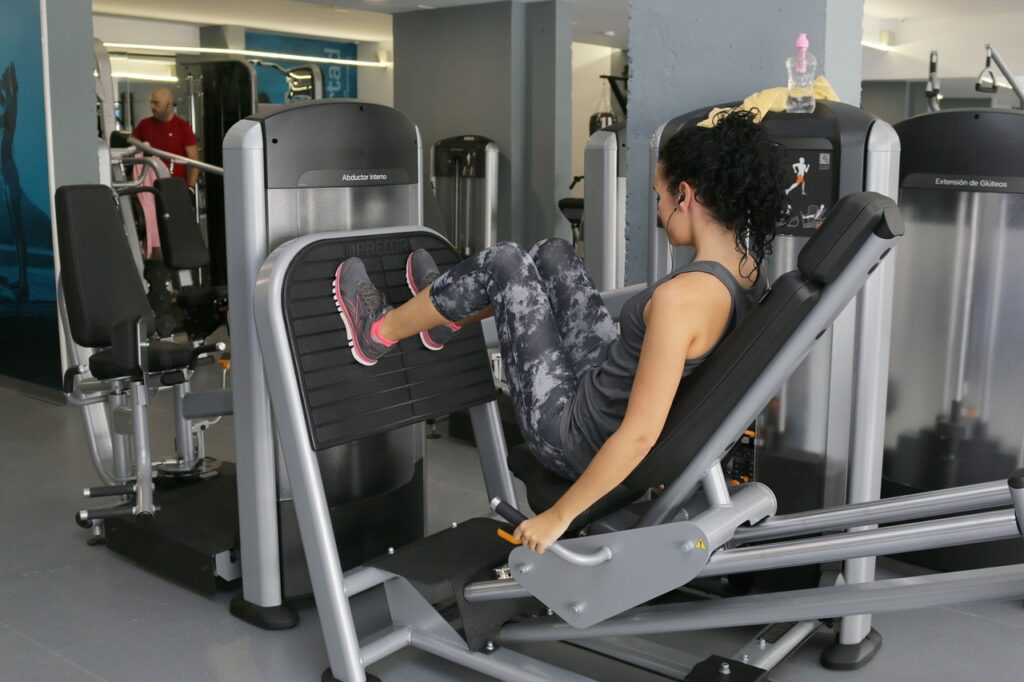
Pilates is a form of exercise that incorporates body control, strength, flexibility, and breath. Joseph Pilates developed it in the early 20th century. Pilates improves strength, flexibility, posture, and mental awareness for overall well-being.
Pilates is a type of exercise that focuses on building strength, flexibility, and endurance through controlled movements. Joseph Pilates developed it in the early 20th century. The exercises in Pilates primarily target the body’s core muscles, such as the abdominal muscles, lower back, hips, and buttocks.
Pilates emphasizes proper alignment, breathing techniques, and mindful movement to improve posture, balance, and overall body awareness. It can be done on a mat or using specialized equipment, like the Pilates reformer, Cadillac, or chair.
Pilates is often recommended for injury prevention, rehabilitation, and improving overall physical fitness. Pilates exercises often target the deep core muscles, including the abdominals, back muscles, and pelvic floor. Controlled, precise, and flowing motions characterize the movements in Pilates.
They are typically performed on a mat or using specialized equipment, such as a reformer machine or Cadillac. The principles of Pilates include concentration, control, centering, precision, breath, and flowing movements. These principles are integrated into the exercises to develop core stability, improve balance, enhance coordination, and increase body awareness.
Pilates can benefit individuals of various fitness levels and goals, from beginners to professional athletes. It can be adapted to meet individual needs and can be very helpful for improving posture, rehabilitating injuries, and enhancing overall physical fitness and mental well-being.
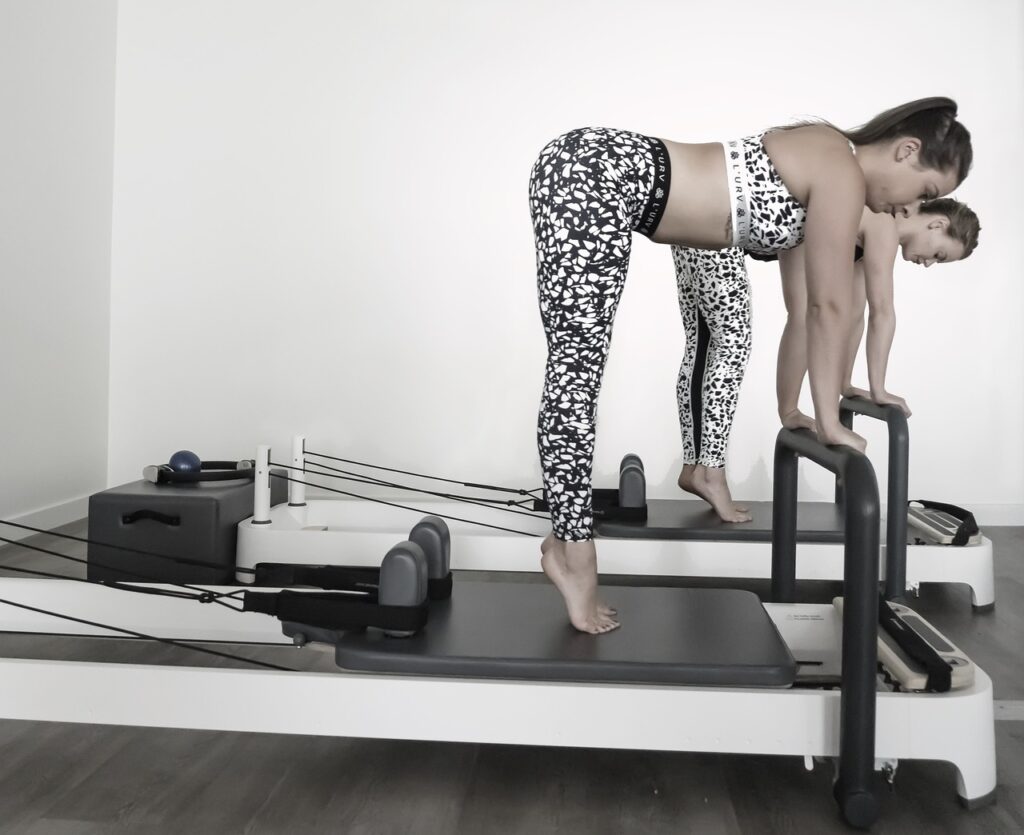
What Are The Benefits Of Pilates?
Pilates offers several benefits for both the body and the mind. Some of the key benefits include:
1. Improved core strength: Pilates focuses on strengthening the deep muscles of the abdomen, back, and pelvis. This helps to enhance core stability and support proper alignment and posture.
2. Increased flexibility: Pilates exercises promote lengthening and stretching muscles, improving flexibility and range of motion. This can help reduce muscle stiffness and improve overall mobility.
3. Enhanced muscular strength and endurance: Pilates helps build strength and endurance by targeting specific muscle groups. It can tone and sculpt muscles, particularly in the core, arms, legs, and buttocks.
4. Better posture and body alignment: Pilates emphasizes proper body alignment, which can correct imbalances and postural issues. It helps to improve spinal alignment, reduce muscle imbalances, and promote a more upright and graceful posture.
5. Injury prevention and rehabilitation: Pilates exercises focus on gentle, controlled movements that put minimal stress on the joints. This makes it an ideal form of exercise for injury prevention and rehabilitation, aiding in the recovery of various musculoskeletal conditions.
6. Increased body awareness: Pilates emphasizes mindfulness and concentration, requiring participants to participate in their movements fully. This helps individuals better understand their bodies, movement patterns, and imbalances or misalignments.
7. Stress reduction: Pilates involves controlled breathing techniques and encourages a mindful and focused mindset. This can help reduce stress levels, promote relaxation, and improve mental well-being.
8. Improved coordination and balance: Many Pilates exercises involve coordinated movements of different muscle groups. This can improve neuromuscular coordination and enhance balance and stability.
9. Low impact and accessible: Pilates is a low-impact form of exercise that can be adapted to different fitness levels, ages, and abilities. It is gentle on the joints and can be modified to suit individual needs, making it accessible to a wide range of people.
Pilates can help individuals achieve a balanced and aligned body, increase strength and flexibility, prevent injuries, and promote overall well-being.
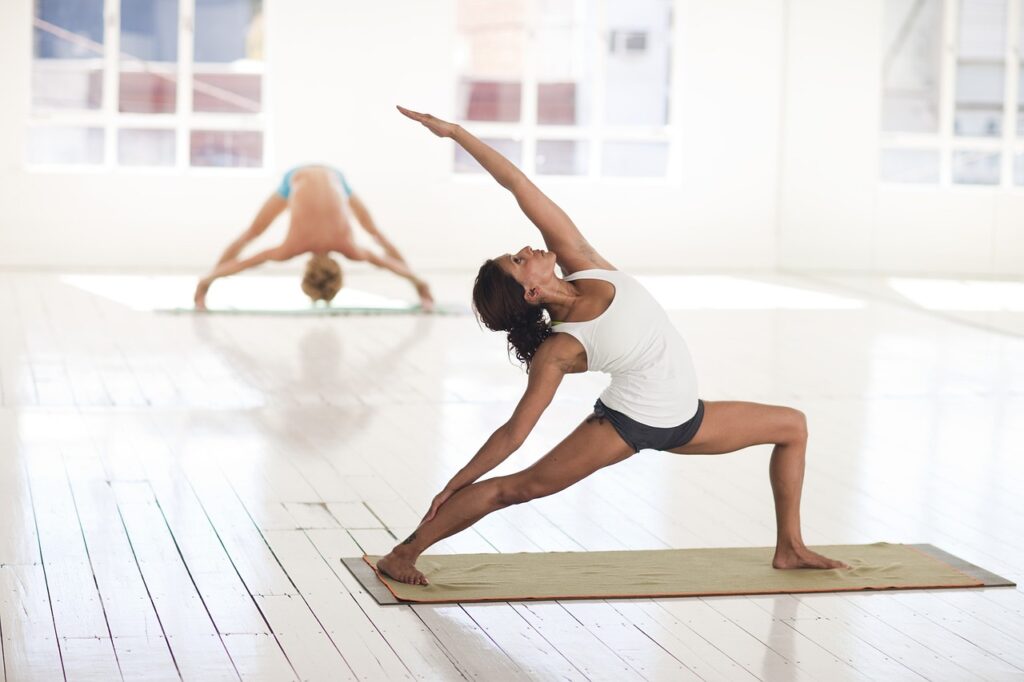
Yoga is a practice that originated in ancient India and encompasses physical, mental, and spiritual elements. It involves a set of physical postures (asanas), breathing techniques (pranayama), meditation, and ethical principles to promote overall well-being and inner peace.
The physical aspect of yoga focuses on performing various poses or asanas to improve flexibility, strength, and balance. These postures are often combined with controlled breathing to create a flow of movement and promote mindfulness. Yoga is about physical exercise, calming the mind, reducing stress, and promoting self-awareness.
Yoga is known for its numerous benefits, which include:
1. Increased flexibility and range of motion.
2. Improved strength and muscle tone.
3. Better posture and alignment.
4. Enhanced balance and coordination.
5. Stress reduction and relaxation.
6. Increased focus and mental clarity.
7. Improved breathing and lung capacity.
8. Better sleep quality.
9. Boosted immune system.
10. Overall sense of well-being and inner peace.
Yoga is a highly adaptable practice that can be modified to suit different fitness levels and needs. There are various styles of yoga, including Hatha, Vinyasa, Ashtanga, Iyengar, Kundalini, Ashtanga, Bikram, and Yin yoga, each with its own emphasis and approach.
It is suitable for individuals of all ages and fitness levels, as modifications can be made to accommodate different capabilities and needs.
While yoga has physical benefits, it ultimately seeks to unite the body, mind, and spirit. It offers a path to self-discovery, inner peace, and a deeper connection to oneself and the surrounding world.
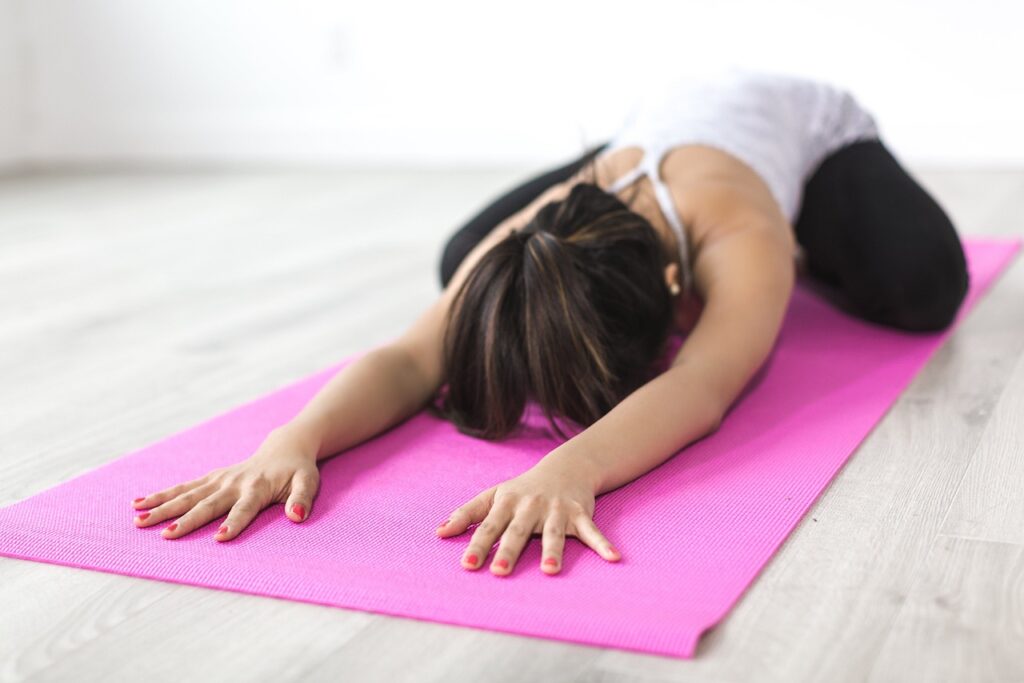
What Are The Benefits Of Yoga
Yoga offers a wide range of physical, mental, and emotional benefits.
Some of the key benefits of regular yoga practice include:
1. Improved flexibility and mobility: Yoga poses and stretches target different muscle groups, helping to increase flexibility, range of motion, and joint health.
2. Increased strength and tone: Yoga poses often require engaging and sustaining muscle contractions, which can help build strength and tone muscles throughout the body.
3. Better posture and alignment: Yoga helps promote proper postural alignment, reducing muscle imbalances and strain. It can improve overall posture and spinal health.
4. Stress reduction and relaxation: Practicing yoga involves mindful movement, deep breathing, and meditation, which can reduce stress levels, calm the nervous system, and promote relaxation and mental clarity.
5. Improved breathing and lung function: Yoga incorporates specific breathing techniques (pranayama) that enhance lung capacity, improve respiratory function, and increase oxygen intake.
6. Enhanced mental well-being: Yoga combines physical movement with conscious breathing and mindfulness, which can reduce anxiety depression, and promote overall mental well-being. It may also improve focus, concentration, and sleep quality.
7. Better cardiovascular health: Certain dynamic forms of yoga, such as Vinyasa or Power Yoga, can benefit cardiovascular by increasing heart rate and improving circulation.
8. Boosted immune system: Regular yoga practice has positively impacted the immune system, improving overall health and resilience against illness.
9. Improved digestion and metabolism: Certain yoga poses and breathing exercises can stimulate digestion, improve nutrient absorption, and support a healthy metabolism.
10. Increased body awareness and self-acceptance: Yoga cultivates body awareness, helping individuals reconnect with their bodies and develop a positive relationship with themselves. It promotes self-acceptance and self-care.
11. Injury prevention and rehabilitation: Practicing yoga mindfully and with proper alignment can help improve body mechanics, prevent injuries, and support the rehabilitation process for existing injuries.
12. Overall well-being and quality of life: Regular yoga practice can improve well-being and increase self-confidence and a greater appreciation for life.
Key Takeaways
- The positive benefits of yoga are that it improves your health and fitness.
- The practice can be adapted to suit your individual needs and abilities.
- Learning yoga from a qualified instructor is recommended to ensure safe and effective practice.
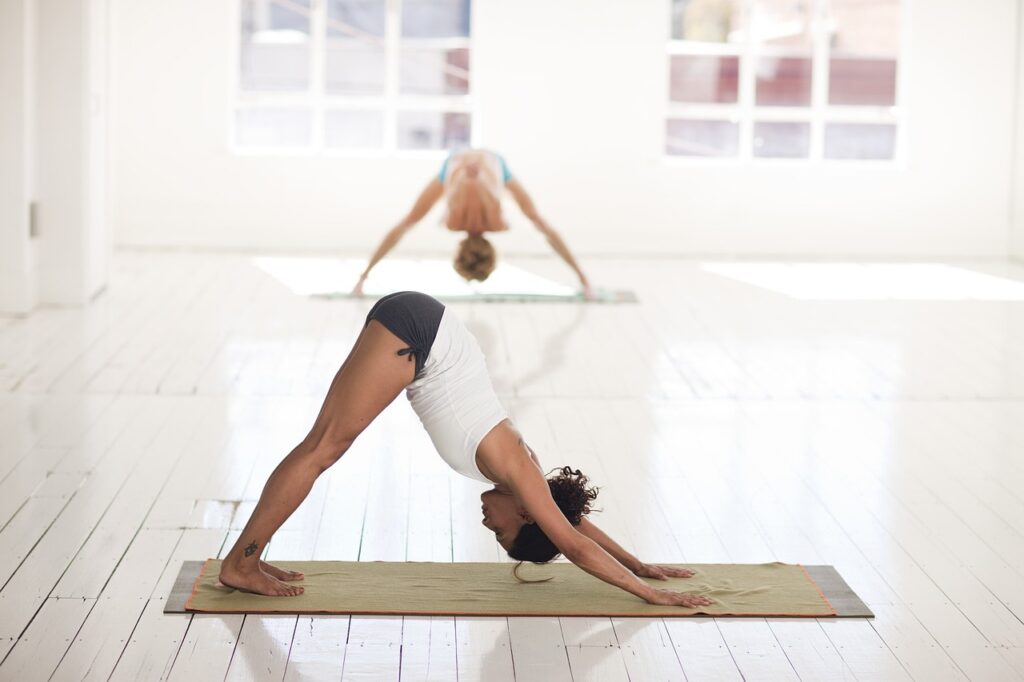
Pilates as a Precursor to Yoga
Pilates is a valuable precursor to yoga, as it can help learners develop the strength, flexibility, and control needed for more advanced yoga poses. For those interested in exploring yoga, trying Pilates first may be a helpful way to build a foundation for their practice.
Overall, Pilates can be seen as a precursor to yoga for someone interested in yoga. trying Pilates can help them with the strength and control needed for more advanced yoga poses.
The Mind-body Connection
Both practices emphasize the connection between the mind and body. While yoga is largely unassisted and typically involves practicing on a mat. Pilates incorporates equipment, some of which includes spring tension.
This spring tension can be resistive or assistive, making learning basic movements and exercises easier. Pilates can, therefore, be a helpful precursor to yoga, particularly for those who find yoga challenging.
Pilates can be a helpful starting point for individuals interested in practicing yoga to build strength, flexibility, and coordination. Once comfortable with Pilates, individuals may find transitioning to yoga and practicing on the mat easier.: Both practices emphasize the connection between the mind and body.
Key Takeaways
- Pilates can be a helpful starting point for individuals interested in practicing yoga to build strength, flexibility, and coordination.
- Once comfortable with Pilates, individuals may find transitioning to yoga and practicing on the mat easier.
- Both practices emphasize the connection between the mind and body.
Conclusion
While Pilates and yoga share many similarities, key differences exist between the two practices. Pilates is based on yoga principles such as control, centering, coordinated movement, and breath, but it also incorporates equipment with spring tension.
This equipment can be both resistive and assistive, making it easier for beginners to learn the basic movements of the exercises. Pilates can also serve as a precursor to yoga, helping individuals work towards more advanced yoga practices.
Overall, Pilates and yoga offer a range of physical and mental benefits and can be enjoyable practices for individuals of all levels.
Frequently Asked Questions
1. Q: Are Pilates and yoga the same thing?
1. A: Pilates and yoga are not the same but share many similarities. While both practices emphasize mind-body connection, control, and breath, they have different origins, focuses, and movements.
2. Q: Which practice should I choose, Pilates or yoga?
2. A: The choice between Pilates and yoga depends on your personal preferences, goals, and fitness level. Pilates may be a good fit if you prefer structured movements, focus on core strength, and want a workout-oriented approach. Yoga may be more suitable if you choose a broader range of movements, spiritual exploration, and relaxation.
3. Q: Can I do both Pilates and yoga?
3. A: Yes, many people enjoy and benefit from both practices. They can complement each other, providing a well-rounded approach to physical fitness, flexibility, and mental well-being.
4. Q: Can Pilates prepare me for yoga?
4. A: Pilates can be an excellent precursor to yoga. Pilates helps build foundational strength, core stability, and body control, which can be beneficial when transitioning to more advanced yoga poses.
5. Q: Can I do Pilate and yoga on the same day?
5. A: Yes, you can do Pilates and yoga on the same day, but it is important to listen to your body and not overexert yourself. Alternating days or incorporating both practices into a well-balanced routine may be beneficial.
6. Q: Do I need any special equipment for Pilates and yoga?
6. A: Pilates can involve specialized equipment like reformer machines or chairs, but it can also be done on a mat with minimal equipment. Yoga typically requires a mat, but additional props like blocks, straps, or bolsters can enhance your practice. However, practicing both Pilates and yoga with just a mat is possible.
7. Q: Are Pilates and yoga suitable for beginners?
7. A: Yes, both Pilates and yoga can be adapted for beginners. It is advisable to start with beginner-level classes or seek guidance from qualified instructors who can help you learn the correct techniques and progress safely in your practice.
8. Q: Can Pilates and yoga help with stress and relaxation?
8. A: Yes, both practices can help reduce stress and promote relaxation. The combination of movement, breathwork, and mindfulness in Pilates and yoga can positively impact mental well-being.
9. Q: What are the health benefits of Pilates and yoga?
9. A: Pilates and yoga offer a range of health benefits, including improved strength, flexibility, posture, balance, and core stability. They can also help reduce stress, increase body awareness, enhance relaxation, and promote overall mental well-being.
10. Q: Is either Pilates or yoga better for weight loss?
10. A: Pilates and yoga can contribute to weight loss, as they help improve overall fitness levels, increase calorie burn, and promote muscle tone. However, other factors such as dietary changes and additional cardio exercises are typically recommended for more significant weight loss goals.
11. Q: Can Pilates and yoga help with injury rehabilitation?
11. A: Yes, Pilates and yoga can be beneficial for injury rehabilitation. They offer low-impact movements that can help strengthen and stabilize muscles, promote joint mobility, and aid recovery. It is important to consult with a healthcare professional or qualified instructor to ensure proper modifications and guidance.
12. Q: Are there any age restrictions for Pilates and yoga?
12. A: Pilates and yoga can be practiced by people of various ages. They can be adapted to suit different fitness levels and abilities. However, consulting with a healthcare professional or qualified instructor is always advisable, especially for older adults or individuals with pre-existing health conditions.
13. Q: Can pregnant women practice Pilates or yoga?
13. A: With proper modifications, pregnant women can practice Pilates and yoga. Prenatal versions of these practices are designed to accommodate the changing needs and limitations during pregnancy. It is essential to seek guidance from qualified instructors trained in prenatal exercises.
14. Q: How often should I practice Pilates or yoga?
14. A: The frequency of practice depends on individual goals, fitness level, and availability. A consistent practice of 2-3 weekly sessions can benefit general health and well-being. However, listening to your body, avoiding overexertion, and allowing for adequate rest and recovery is important.
15. Q: Can Pilates and yoga help improve posture?
15. A: Yes, both Pilates and yoga can help improve posture by strengthening core muscles, promoting spinal alignment, and increasing body awareness. They focus on developing balanced muscle strength and length, which can contribute to better posture.
16. Q: Are Pilates and yoga suitable for men?
16. A: Yes, Pilates and yoga are suitable for men. While they are sometimes considered predominantly female-focused practices, both offer numerous benefits for men, including improved strength, flexibility, posture, and stress management. Many athletes and fitness enthusiasts, including male athletes, incorporate Pilates and yoga into their training routines.
17. Q: How long does it take to see results from Pilates or yoga?
17. A: The time it takes to see results can vary depending on various factors, including consistency of practice, individual fitness level, and specific goals. With regular practice, individuals may start noticing improvements in strength, flexibility, and overall well-being within a few weeks to a few months.
Share via:


Comments are closed